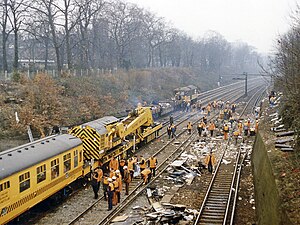Clapham Junction rail crash

Clearing up after the collision
|
|
| Date | 12 December 1988 |
|---|---|
| Time | 08:10 |
| Location | near Clapham Junction |
| Country | United Kingdom |
| Rail line | South Western Main Line |
| Operator | Network SouthEast |
| Cause | Unprotected wrong-side failure |
| Statistics | |
| Trains | 3 |
| Deaths | 35 |
| Injuries | 69 serious, 415 minor |
| List of UK rail accidents by year | |
On the morning of 12 December 1988, a crowded passenger train crashed into the rear of another train that had stopped at a signal, just south of Clapham Junction railway station in London, and subsequently sideswiped an empty train travelling in the opposite direction. A total of 35 people were killed in the collision, while 484 were injured.
The collision was the result of a signal failure caused by a wiring fault. New wiring had been installed, but the old wiring had been left in place and not adequately secured. An independent inquiry, chaired by Anthony Hidden, QC, found that the signalling technician responsible had not been told his working practices were wrong and his work had not been inspected by an independent person. He had also performed the work during his 13th consecutive week of seven-day workweeks. Critical of the health and safety culture within British Rail at the time, Hidden's recommendations included ensuring that work was independently inspected and that a senior project manager be made responsible for all aspects of any major, safety-critical project such as re-signalling work.
British Rail was fined £250,000 for violations of health and safety law in connection with the accident.
On 12 December 1988 the 07:18 from Basingstoke to London Waterloo, a crowded train made up from three four-car 4Vep electric multiple units, was approaching Clapham Junction when the driver saw the signal ahead of him change from green ("proceed") to red ("danger"). Unable to stop at the signal, he stopped his train at the next signal and then reported to the signal box by telephone. He was told there was nothing wrong with the signal. Shortly after 08:10, the following train, the 06:30 from Bournemouth, made up of a 4-REP and two 4TC multiple units, collided with the Basingstoke train. A third train, carrying no passengers and made of two four-car 4Vep units, was passing on the adjacent line in the other direction and collided with the wreckage immediately after the initial impact. The driver of a fourth train, coasting with no traction current, saw the other trains and managed to come to a stop behind the other two and the signal that should have protected them, which was showing a yellow "caution" aspect instead of a red "danger" aspect.
...
Wikipedia
